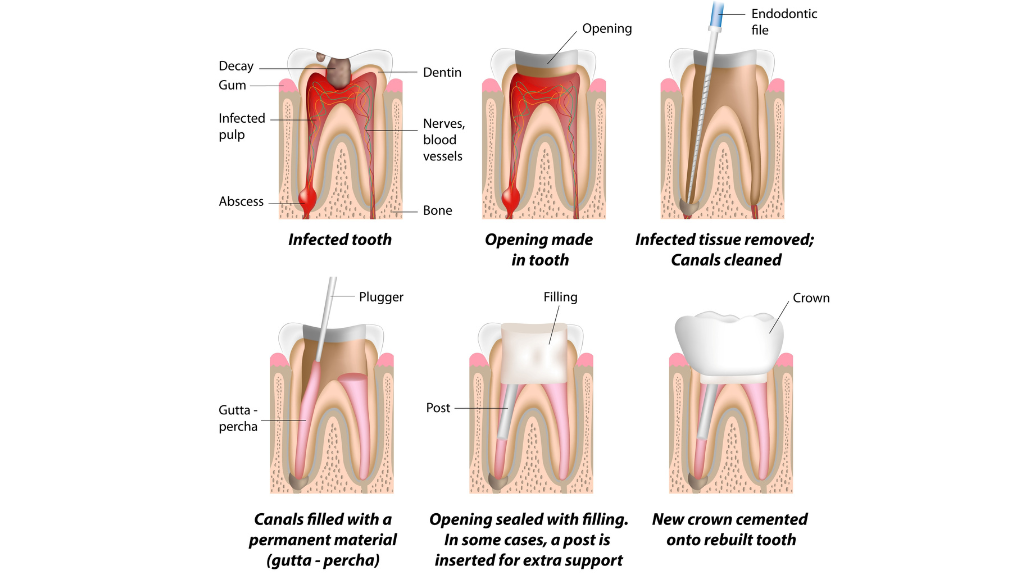
📅
By: Dr Jess Wong
What is Root Canal Treatment?
If you’ve ever experienced a severe toothache or if a filling is large, deep and causing problems, your dentist might have recommended a root canal treatment. While the term might sound scary, root canal therapy is a common dental procedure designed to save a damaged tooth and relieve pain. At Mascot Dental Clinic, we want to ensure that you understand what to expect during a root canal so you can feel comfortable and confident in your treatment.
Root canal treatment (also known as endodontic therapy) is a procedure used to treat infection or inflammation within the pulp of the tooth. The pulp is the soft tissue inside your tooth that contains nerves and blood vessels. When the pulp becomes infected or damaged due to decay, a crack, or trauma, it can cause severe pain, swelling, and even lead to an abscess. Sometimes it causes less noticeable symptoms like colour change or changes in the bone.
The goal of a root canal is to remove the infected pulp, clean and disinfect the inside of the tooth, and seal it to prevent future infections. This process helps save the natural tooth, avoiding the need for extraction, and preserves your smile and dental health.
If left untreated, a tooth infection can spread to other areas of your mouth and may lead to serious complications. That’s why it’s crucial to address these issues promptly. Usually, the alternative to root canal treatment is to extract the tooth, which may not be ideal as it can impact the appearance of your smile and how you eat and chew.
The 3 Main Steps of Root Canal Treatment
Root canal treatment typically involves three main stages: Extirpation, Instrumentation, and Obturation. Depending on the severity of the initial infection, some steps may take longer or more time may be required. Here’s a detailed look at what each step involves or visit our Facebook/ Instagram for videos describing the process.
1. Extirpation (Cleaning the Tooth)
The first step in the root canal procedure is called Extirpation, where the infected or damaged pulp is removed from the tooth. This step involves:
- Numbing the tooth: Local anesthesia is used to ensure that you feel comfortable and as pain-free as possible throughout the procedure.
- Accessing the pulp chamber: A small opening is created in the crown of the tooth to reach the pulp chamber and root canals.
- Removing the infected pulp: The infected or inflamed pulp tissue is carefully removed from the chamber and canals using specialized dental instruments.
2. Instrumentation (Cleaning and Shaping)
The next step is Instrumentation, which involves cleaning, disinfecting, and shaping the inside of the tooth to prepare it for filling. This is crucial because it ensures that the root canals are completely cleaned and disinfected, creating a stable foundation for the final step of the treatment. This is actually harder than it sounds! Most teeth have multiple canals that may be curved or bent. Within those canals, there may also be smaller canals that can harbour bacteria and all of these need to be disinfected. During this stage:
- Thin, flexible instruments are used to clean the walls of the root canals, removing any remaining bacteria and debris.
- The canals are shaped into a smooth, tapered form to make them easier to fill properly.
- An antibacterial solution may be used to flush out any lingering bacteria and to reduce the risk of reinfection.
3. Obturation (Filling and Sealing)
The final stage of the root canal procedure is called Obturation, where the cleaned canals are filled and sealed to prevent future infection. This step involves:
- Filling the canals: The empty canals are filled with a biocompatible material called gutta percha, which helps to seal them off and prevent bacteria from re-entering.
- Sealing the tooth: A temporary filling is placed over the opening of the tooth to protect it until a permanent restoration (such as a crown) can be placed.
- Restoring the tooth: In most cases, the dentist will recommend placing a crown over the treated tooth to provide strength, protection, and restore its function.
The obturation step is vital for ensuring that the root canal is properly sealed off from bacteria, which reduces the chances of reinfection.
After the Root Canal Treatment
During your root canal treatment, it’s normal to experience some mild discomfort for a few days as your tooth and surrounding tissues heal. Over-the-counter pain medication is usually enough to manage this discomfort. Our team at Mascot Dental Clinic will provide you with aftercare instructions to help you recover quickly and comfortably.
A follow-up appointment may be scheduled to place a permanent crown on your tooth to strengthen and protect it. Once the crown is in place, your tooth will look and function just like a natural tooth!
How we can help
Root canal treatment is a highly effective way to save a damaged or infected tooth, relieving pain and restoring your smile. At Mascot Dental Clinic, we use advanced techniques to ensure the procedure is as comfortable and successful as possible. Understanding each step—Extirpation, Instrumentation, and Obturation—can help put your mind at ease, knowing that you’re in good hands.
If you’re experiencing tooth pain or think you might need a root canal, do not hesitate to Contact Us.
Tags: #Root Canal Treatment